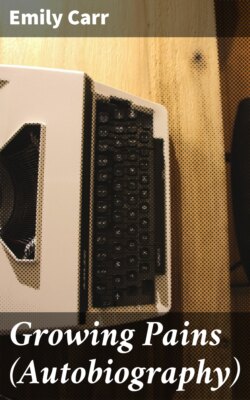Читать книгу Growing Pains (Autobiography) - Emily Carr - Страница 15
На сайте Литреса книга снята с продажи.
BEANY
ОглавлениеTable of Contents
Miss Beaner the little hunchback did not feel herself insignificant. She did not come up to any of our shoulders as she stood at her easel.
She always picked the biggest images to draw from, preferably Venus. There she stood, her square little chin thrust out, her large feet firmly planted, claw-fingers clutching her charcoal, long arms swinging, and such pitifully poor results! She stood so close under the great images she drew that they were violently foreshortened and became twice as difficult to draw. With her pathetic eyes rolled upwards devouringly and her misshapen body Beany looked foreshortened herself as if a heavy weight had crushed her head down into her hips forcing what was between into a cruel humped ridge.
Beany’s art efforts were entirely ineffectual. The drawing master obviously disliked going near the deformed creature. Noted always for his terse criticism, all Beany ever got from him was, “Turn over and begin again.” Beany turned and turned, her eyes filled with tears. She never got beyond beginnings.
As soon as the master left the room one or another student would go to Beany and say, “He gave everyone a rotten lesson today.” That made Beany feel better. Then the student would find something encouraging to say about the poor lines and smudges on her paper and Beany’s long spidery arms would flurry around the helper’s neck, her head burrow into their waist-line. Beany hugged with a horrible tightness when grateful.
Coming from school one day I found a kitten trapped behind the heavy street door at the foot of the outer stair. It was ravenous for food and for petting. It begged so hard to be hugged that I thought of Beany. Maybe the kitten would satisfy her hug-longing. I took it home that night and offered it to Beany next day. She was delighted. As it was a half holiday, I said I would take it to her house that afternoon.
Beany lived in one of the older and shabbier parts of San Francisco. The front door of the house opened right into the parlour, a drab room full of vases filled with artificial flowers. There was, too, a stuffed canary under glass and some sea shells. The room was a sepulchre. The mantelpiece was draped with the stars and stripes. On the stone hearth (fireless because it was summer) sat a plate of fish cleaned and ready to cook. The kitten made a dart towards the fish. Beany raised them to the mantelpiece, remarking as she fanned her hot face with a small brass fire shovel, “Our parlour hearth is the coolest place in the house.” She was delighted with her kitten and hugged and hugged, first the kitten, then me. Poor Beany, she had so little and could have done with so much. I felt furious all over again with the drawing master’s cruel “crits”, his not bothering to hide how he loathed her person and despised her work.
The Frenchman who taught us painting was different from the drawing master. His “crits” were severe, but his heart was soft—too soft almost. He championed any poor, weak thing. One day he found the little halfwit Jew-boy with his head down on a table of still-life stuff crying into the heap of carrots, onions and beets.
“What is it, Benny?” The master’s hand on the boy’s head covered it like a hat.
Benny lifted a wet, swollen cheek.
“Dis’ mornin’ I woked an’ de’ look-glass tell, ‘You got de’ toot’-ache, Benny.’ Boys dey say, ‘Why you so fat one side, Benny?’ I say, ‘De look-glass say I got toot’-ache.’ Boys make tease of me!”
A group of grinning students were peeping from behind the screen.
“Make off there! None of that!” roared the professor.
After that he always kept an eye on Benny. That was the spirit of the old Art School. It seemed that here there was always a champion for the Beanys and the Bennys.
